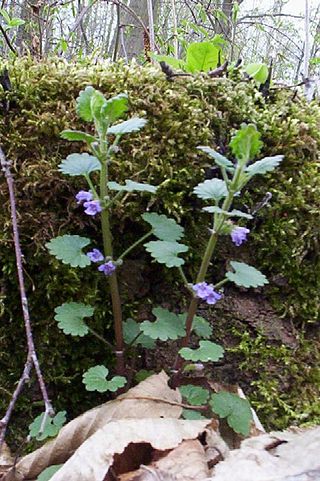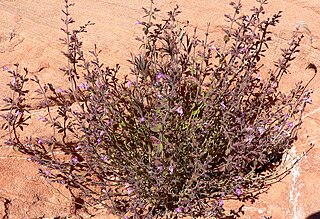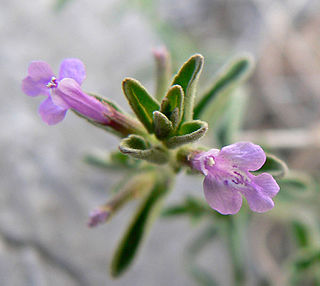
Mentha is a genus of plants in the family Lamiaceae. The exact distinction between species is unclear; it is estimated that 13 to 24 species exist. Hybridization occurs naturally where some species' ranges overlap. Many hybrids and cultivars are known.

Spearmint, also known as garden mint, common mint, lamb mint and mackerel mint, is a species of mint, Mentha spicata (, native to Europe and southern temperate Asia, extending from Ireland in the west to southern China in the east. It is naturalized in many other temperate parts of the world, including northern and southern Africa, North America, and South America. It is used as a flavouring in food and herbal teas. The aromatic oil, called oil of spearmint, is also used as a flavoring and sometimes as a scent.

Mentha pulegium, commonly (European) pennyroyal, or pennyrile, also called mosquito plant and pudding grass, is a species of flowering plant in the mint family, Lamiaceae, native to Europe, North Africa, and the Middle East. Crushed pennyroyal leaves emit a very strong fragrance similar to spearmint. Pennyroyal is a traditional folk remedy, emmenagogue, abortifacient, and culinary herb, but is toxic to the liver and has caused some deaths. European pennyroyal is related to an American species, Hedeoma pulegioides. Though they differ in genera, they share similar chemical properties.

Glechoma hederacea is an aromatic, perennial, evergreen creeper of the mint family Lamiaceae. It is commonly known as ground-ivy, gill-over-the-ground, creeping charlie, alehoof, tunhoof, catsfoot, field balm, and run-away-robin. It is also sometimes known as creeping jenny, but that name more commonly refers to Lysimachia nummularia. It is used as a salad green in many countries. European settlers carried it around the world, and it has become a well-established introduced and naturalized plant in a wide variety of localities. It is also considered an aggressive invasive weed of woodlands and lawns in some parts of North America. In the absence of any biological control, research conducted by the USDA herbicides are relied upon particularly for woodland ecosystems. The plant's extensive root system makes it difficult to eradicate by hand-pulling.
Pennyrile may refer to any of the following:
Emmenagogues are herbs which stimulate blood flow in the pelvic area and uterus; some stimulate menstruation. Women use emmenagogues to stimulate menstrual flow when menstruation is absent for reasons other than pregnancy, such as hormonal disorders or conditions like oligomenorrhea.

Pulegone is a naturally occurring organic compound obtained from the essential oils of a variety of plants such as Nepeta cataria (catnip), Mentha piperita, and pennyroyal. It is classified as a monoterpene.

Glechoma is a genus of flowering plants in the mint family, Lamiaceae, first described for modern science in 1753. It is distributed in northern Asia and Europe with a center of diversity in Asia, especially China. One species is naturalized in New Zealand and in North America.

Hedeoma is a genus of flowering plants in the mint family, Lamiaceae. It is native to North and South America. They are commonly known as false pennyroyals.

Mentha cervina, commonly known as hart's pennyroyal, is a perennial herbaceous plant of the Mentha (mint) genus. It is native to the western Mediterranean Sea region, growing naturally from southwestern France to the Iberian Peninsula, and south to Azores, Morocco and Algeria. Its common name reflects a traditional association with the separate species Mentha pulegium or pennyroyal. The plants were associated due to their shared high pulegone content, which gives them both a distinctive, strong aroma.

Hedeoma drummondii is a species of flowering plant in the mint family known by the common name Drummond's false pennyroyal. It is native to western North America, where it is distributed mainly in the United States west of the Mississippi River and adjacent Mexico. This is a hairy perennial herb with an erect mintlike form up to 45 centimeters tall. The oppositely arranged paired leaves are linear to narrowly oval in shape, pointed, and up to about a centimeter long. The leaves have a strong sweet mint scent when crushed. The herb tastes like peppermint and is used as a minty flavoring in parts of Mexico. The inflorescence arises from the axils of these leaf pairs, bearing three to seven flowers each between one and two centimeters in length on short pedicels. The flowers are generally light to deep lavender with some white markings. The fruit is a waxy, mucilaginous nutlet.

Hedeoma todsenii is a rare species of flowering plant in the mint family known by the common name Todsen's pennyroyal, or Todsen's false pennyroyal. It is endemic to New Mexico in the United States, where it occurs in the San Andres and Sacramento Mountains. It is federally listed as an endangered species of the United States.

Thymus pulegioides, common names broad-leaved thyme or lemon thyme, is a species of flowering plant in the family Lamiaceae, native to Europe. Growing to 5–25 cm (2–10 in) tall by 25 cm (10 in) wide, it is a small spreading subshrub with strongly aromatic leaves, and lilac pink flowers in early summer. The specific epithet pulegioides highlights its similarity to another species within Lamiaceae, Mentha pulegium (pennyroyal).

Hedeoma reverchonii, commonly called Reverchon's false pennyroyal, is a species of flowering plant in the mint family (Lamiaceae). It is native to the south central region of the United States, where it is primarily found in Texas, extending into small areas of Arkansas and Oklahoma. Its natural habitat is on open, calcareous rock outcrops.

Mentha gattefossei is a plant species in the genus Mentha, endemic to the Atlas Mountains of Morocco. It was first described by French botanist René Maire in 1922. Harvested for its essential oil, M. gattefossei has seen use in traditional medicine, pest control and as a food seasoning.
Mentha japonica is a plant species in the genus Mentha, endemic to the islands of Hokkaido and Honshu, Japan. Initially described as Micromeria japonica by Friedrich Anton Wilhelm Miquel, it was first identified under its present name by Japanese botanist Tomitaro Makino in 1906. A relatively rare plant, it is classified by the Japanese Ministry of Environment as a Near Threatened species.
Mentha grandiflora is a plant species in the genus Mentha, endemic to eastern Australia. The species was described in 1848 by botanist George Bentham. Its epithet, grandiflora, means "with large flowers".
Mentha micrantha, is a plant species in the genus Mentha, native to western Kazakhstan and southeastern Russia. The species was described in 1890 by botanist George Bentham. Its epithet, micrantha, means "with small flowers." It is unique among its genus as the only species that is an annual plant.















